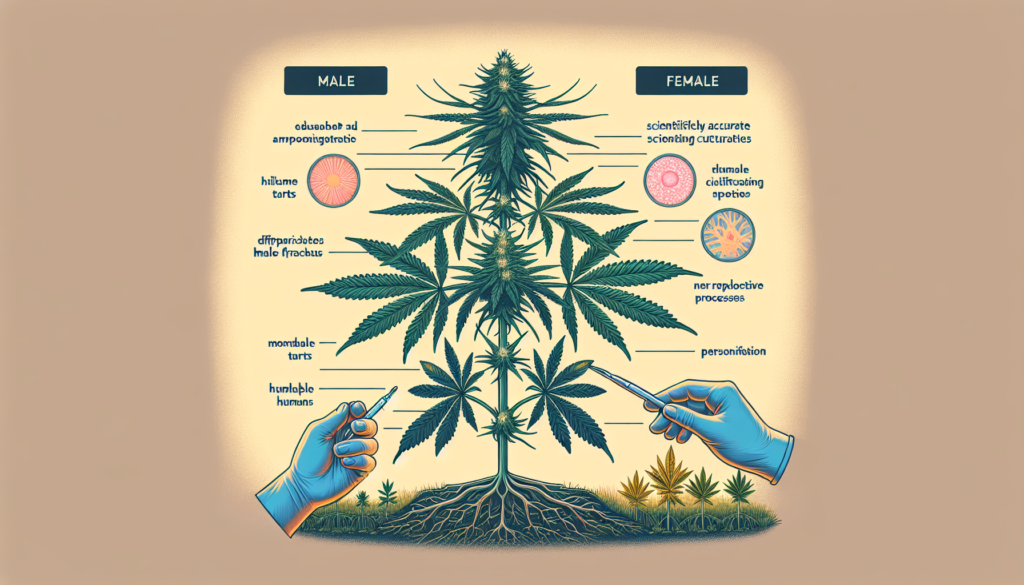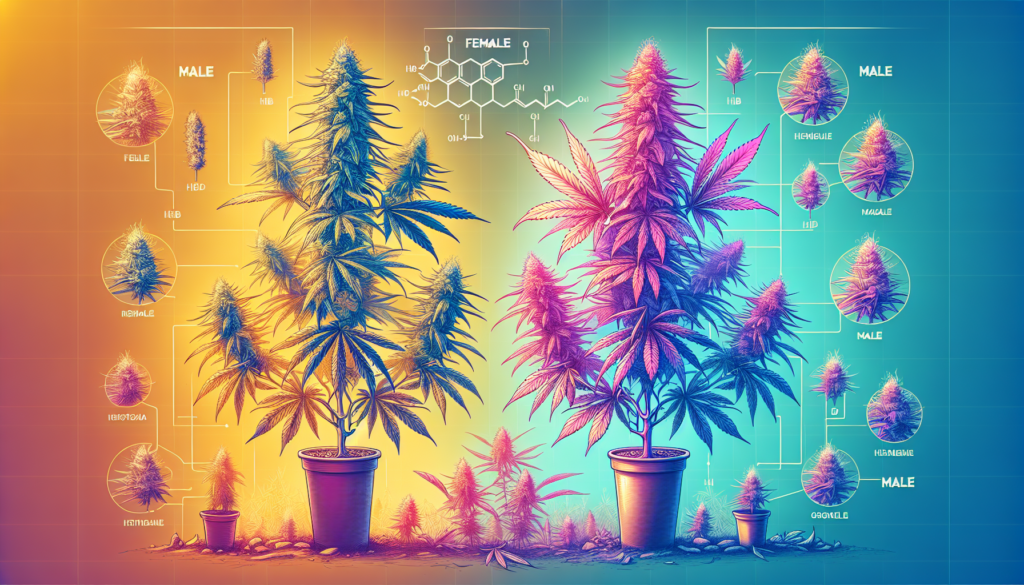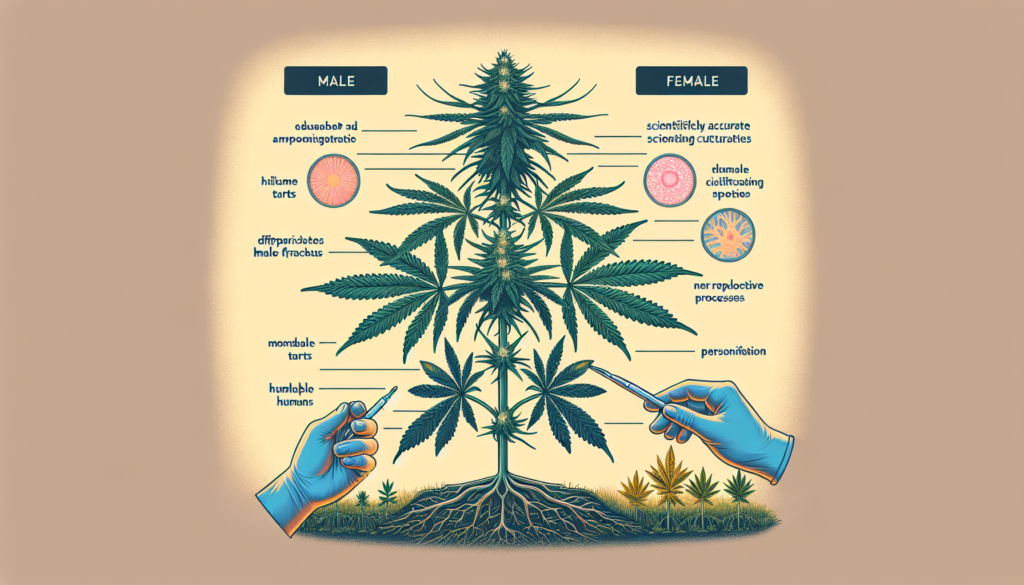Male Vs Female Cannabis Plant

Male Vs Female Cannabis Plant. You’re about to enter the intriguing world of the male vs. female cannabis plant. Whether you’re a seasoned enthusiast or new to this botanical realm, understanding the differences between these two sexes will unlock endless insights into the cultivation and consumption of cannabis. From their unique anatomy to the distinct characteristics they possess, this article will shed light on the fascinating disparities between male and female cannabis plants and why they matter in the world of weed. Get ready to embark on a journey that will forever change the way you perceive and appreciate this remarkable plant.
Growth Characteristics
Plant Structure
The structure of a cannabis plant can vary depending on various factors, including the strain and growing conditions. Generally, cannabis plants have an upright structure with a main stem and several lateral branches. The stem provides support for the plant and helps transport water, nutrients, and sugars throughout the plant. The branches extend from the main stem and play a crucial role in increasing the plant’s surface area for photosynthesis.
Height and Size
Cannabis plants can vary in height and size based on genetics, growing conditions, and the specific strain. Some cannabis plants, known as indicas, tend to be shorter and bushier, while others, called sativas, can grow taller and have a more slender structure. Additionally, environmental factors such as light intensity and nutrient availability can influence the overall size and height of the plant.
Branching Patterns
Branching patterns in cannabis plants can also differ based on genetics and growing conditions. Some plants may have a more symmetrical branching structure, while others may have a more irregular or sparse branching pattern. Branches are important for increasing the surface area for light absorption and enhancing overall plant growth and productivity.
Leaf Structure
The leaves of a cannabis plant are an essential part of its structure and have distinct characteristics. Cannabis leaves are compound leaves, meaning they consist of multiple leaflets attached to a common stalk called a petiole. Each leaflet typically has serrated edges and a pointed tip. The number of leaflets per leaf can vary depending on the strain, with some plants exhibiting fewer leaflets and others having more.
Growth Rate
Cannabis plants are known for their relatively fast growth rate, especially during the vegetative stage. The growth rate can be influenced by factors such as light intensity, nutrient availability, temperature, and overall plant health. With optimal conditions and care, cannabis plants can grow several inches per week, rapidly increasing in size during the vegetative phase before transitioning to the flowering stage.
Reproductive Organs
Male Cannabis Plant
Male cannabis plants play a crucial role in reproduction and the overall cultivation process. They produce pollen sacs or clusters at the leaf joints, which contain the male reproductive cells known as pollen. These pollen sacs eventually burst open, releasing the pollen into the air or onto nearby female plants. Male plants do not produce the desired flower buds that are typically sought after for recreational or medicinal purposes.
Female Cannabis Plant
Female cannabis plants are of particular interest in cultivation due to their ability to produce the resinous flower buds that contain the desired cannabinoids and terpenes. Female plants develop clusters of reproductive structures known as pistils, which contain the female reproductive cells or ovules. When pollinated by male pollen, these ovules can become fertilized and produce seeds, triggering the onset of seed production.
Hermaphrodite Cannabis Plant
In addition to male and female plants, there is also a third category known as hermaphrodite cannabis plants. These plants have both male and female reproductive organs and can self-pollinate if environmental stressors or genetic factors trigger the development of male flowers. While hermaphrodite plants can be useful for breeding purposes, they are generally not desirable in a cultivation setting where the goal is to produce high-quality, seedless flower buds.

Flower Production
Male Cannabis Plant
Male cannabis plants primarily focus on producing pollen for pollination rather than flower buds. Therefore, male plants do not contribute directly to flower production for consumption or extraction purposes. However, they are essential for breeding and creating new strains by providing pollen for the fertilization of female plants.
Female Cannabis Plant
Female cannabis plants are responsible for producing the resinous flower buds that are highly sought after for recreational and medicinal use. These buds contain an abundance of cannabinoids, such as THC and CBD, as well as aromatic compounds called terpenes, which contribute to the plant’s distinct flavors and aromas. Female plants can vary in their flower production, with some cultivars producing high yields of large, dense buds, while others may have smaller, more resinous flowers.
Seed Production
When a female cannabis plant is pollinated by male pollen, it triggers the production of seeds within the flower buds. While seed production is not desirable when cultivating cannabis for consumption or extraction, it can be beneficial for breeding purposes or for developing new strains. However, for most commercial growers, the focus is on seedless flower buds, commonly referred to as sinsemilla, which contain a higher concentration of cannabinoids and terpenes.
Cannabinoid and Terpene Production
Female cannabis plants are known for their ability to produce a rich diversity of cannabinoids and terpenes. These compounds are responsible for the various effects and flavors associated with different cannabis strains. Cannabinoids such as THC and CBD have psychoactive and therapeutic properties, while terpenes contribute to the unique aromas and potential therapeutic benefits of different strains. Female plants typically have higher levels of these compounds compared to male plants.
Cultivation Purposes
Male Cannabis Plant
Male cannabis plants serve a crucial role in cultivation for breeding purposes. By providing pollen for the fertilization of female plants, male plants allow growers and breeders to create new strains with specific desired traits. Depending on the breeder’s goals, male plants may be carefully selected based on their genetic makeup and the traits they exhibit.
Female Cannabis Plant
Female cannabis plants are the primary focus for cultivation in terms of producing the desired flower buds. These plants are often selected based on their flowering characteristics, cannabinoid and terpene profiles, and overall yield potential. Female plants that display desirable traits, such as high resin production, potency, and distinct flavors, are typically favored in commercial cultivation settings.
Breeding and Genetics
Cannabis breeding is an essential aspect of cultivation, allowing growers and breeders to create new strains with specific traits and characteristics. By selectively crossing and mating male and female plants with desired traits, breeders can develop strains that exhibit unique flavors, aromas, and effects. Through generations of breeding and selection, cultivators can enhance desired traits and stabilize genetic lines, ultimately expanding the diversity of strains available to consumers.

Propagation Methods
Cloning
Cloning is a popular propagation method in cannabis cultivation that allows growers to replicate the genetic characteristics of a specific plant. Cloning involves taking cuttings from a mature, healthy plant and encouraging them to develop roots and grow into new plants. By utilizing cloning, growers can maintain the genetic consistency and desirable traits of a particular strain, ensuring consistent flower production and quality.
Seed Germination
Seed germination is another commonly used propagation method in cannabis cultivation. Germinating seeds involves providing the ideal conditions (such as moisture, warmth, and darkness) for a seed to sprout and develop into a seedling. This method is often used when breeders or growers want to introduce new genetic variations and produce diverse offspring. Seed germination allows for genetic exploration and the development of unique phenotypes and traits.
Cannabis Cultivation Techniques
Distinguishing and Removing Males
For growers who aim to cultivate seedless flower buds, it is crucial to distinguish and remove male cannabis plants from the cultivation area. Male plants can be identified by the presence of pollen sacs or clusters at the leaf joints. Early identification and removal of male plants minimize the risk of unintended pollination and seed development, ensuring a higher yield of seedless, cannabinoid-rich flower buds.
Pollination and Seed Production
In some cases, growers may intentionally introduce male plants into the cultivation area to facilitate pollination and seed production. This technique is primarily used for breeding purposes, allowing breeders to create new strains and explore genetic combinations. Controlled pollination and seed production require careful monitoring and isolation to prevent cross-pollination with neighboring female plants that are intended for seedless flower production.
Intensive Female Cultivation
Intensive female cultivation involves maximizing the growth and flower production of female cannabis plants. Growers focus on providing optimal conditions, including light, nutrients, and environmental control, to stimulate vigorous vegetative growth and the development of large, resinous flower buds. The goal is to achieve high yields of potent flower buds by optimizing every aspect of cultivation, from lighting and nutrient schedules to pest and disease management.
Selective Breeding
Selective breeding is a technique used to develop and refine desired traits within a cannabis strain. By crossing specific male and female plants with desired characteristics, breeders can select offspring that exhibit the desired traits and further refine those traits through subsequent generations. This process allows for the creation of strains with enhanced potency, distinct flavors, improved yield, and other desirable attributes.
Plant Health and Vigor
Resistance to Pests and Diseases
Cannabis plants can be vulnerable to various pests and diseases. However, some cultivars exhibit natural resistance or tolerance to specific pests and diseases. By selecting and cultivating resistant strains, growers can minimize the risk of infestations or disease outbreaks, reducing the need for chemical interventions. Additionally, maintaining optimal growing conditions, implementing proper sanitation practices, and regular monitoring can help promote overall plant health and vigor.
Yield and Potency
Plant health and vigor are closely linked to the overall yield and potency of cannabis plants. Healthy plants with robust growth patterns and optimal nutrient uptake are more likely to produce higher yields of quality flower buds. Additionally, proper environmental conditions and care can influence the cannabinoid and terpene profiles of the plants, enhancing the potency and desired effects of the final product.
Harvesting and Processing
Harvesting Female Plants
Harvesting female cannabis plants is a crucial step in the cultivation process to ensure the optimal quality and potency of the flower buds. Timing is critical, as it determines the cannabinoid and terpene profiles as well as the overall maturity of the plant. Growers typically wait until the trichomes on the flower buds have reached their desired level of maturity before harvest, resulting in the highest concentration of cannabinoids and desired effects.
Harvesting Male Plants
For growers interested in seed production or breeding, harvesting male plants is necessary once their pollen sacs have matured and burst open, releasing the pollen. Timely harvesting is crucial to collect the pollen before it disperses naturally. Male plants are typically discarded after harvesting, as they do not contribute directly to the flower production sought after in most cultivation settings.
Processing Techniques
After harvesting, cannabis plants undergo various processing techniques to transform the raw plant material into more refined products. These techniques can include trimming the flower buds to remove excess leaves, drying the buds to reduce moisture content, and curing them to enhance flavors and aromas. Additionally, processing can involve extraction methods to isolate specific cannabinoids and terpenes for various applications, such as concentrates, edibles, or topicals.
Regulation and Legality
Focus on Female Plant Cultivation
In regions where cannabis cultivation is regulated and legal, there is typically a significant emphasis on the cultivation of female plants for flower production. This is because female plants are responsible for producing the desired flower buds containing cannabinoids and terpenes, which are sought after for both medical and recreational use. Regulations often outline specific requirements and guidelines for cultivating and processing female cannabis plants.
Male Plant Restrictions
In regulated cannabis cultivation, male plants are often restricted or prohibited due to their limited value in terms of flower production. Male plants pose a risk of pollination, which can lead to seed development and reduced flower quality. As a result, many cultivators focus exclusively on cultivating female plants to minimize the risk of unintended seed production and to maximize the yield and quality of flower buds.
Industrial Use
While male cannabis plants may not be extensively utilized in recreational or medicinal cannabis cultivation, they do have industrial applications. The fibers obtained from the stalks of male plants can be used to produce textiles, paper, biofuels, and other industrial products. Additionally, male plants can be valuable for breeding purposes, allowing for the development of new strains with desirable traits that can benefit both the recreational and industrial cannabis markets.
Medical and Recreational Use
Importance of Female Plants
In both medical and recreational cannabis markets, female plants play a vital role due to their ability to produce flower buds rich in cannabinoids and terpenes. These compounds have various effects on the human body, including potential therapeutic benefits. The flower buds of female plants are typically consumed through smoking, vaporizing, or ingesting in the form of edibles or tinctures. The potency and strain-specific effects of female plants make them highly sought after for their recreational and medicinal value.
Psychoactive Compounds
Psychoactive compounds, primarily THC (tetrahydrocannabinol), are responsible for the euphoric and intoxicating effects associated with cannabis use. Female plants tend to have higher concentrations of THC compared to male plants, making them more desirable for recreational use. However, it should be noted that there are also non-psychoactive compounds, such as CBD (cannabidiol), which have gained attention for their potential therapeutic properties.
Non-Psychoactive Uses
Beyond the recreational use of cannabis, there is growing interest in the non-psychoactive uses of cannabis-derived products. CBD, a non-psychoactive compound found in cannabis, has gained popularity for its potential therapeutic benefits, including pain relief, reducing anxiety, and alleviating certain medical conditions. Non-psychoactive cannabis products are typically derived from female plants and are sought after by individuals seeking the potential health benefits of cannabis without the intoxicating effects of THC.
Medical Cannabis Strains
Medical cannabis strains are specifically bred to contain higher levels of certain cannabinoids, such as CBD, and lower levels of THC. These strains are often sought after by patients who are using cannabis for medicinal purposes, such as managing chronic pain, alleviating symptoms of epilepsy, or reducing chemotherapy-induced nausea. The development of medical cannabis strains relies heavily on the cultivation and selection of female plants with specific cannabinoid and terpene profiles to meet the needs of different medical conditions.
Thanks for checking out my:
Male Vs Female Cannabis Plant
Smoke em’


